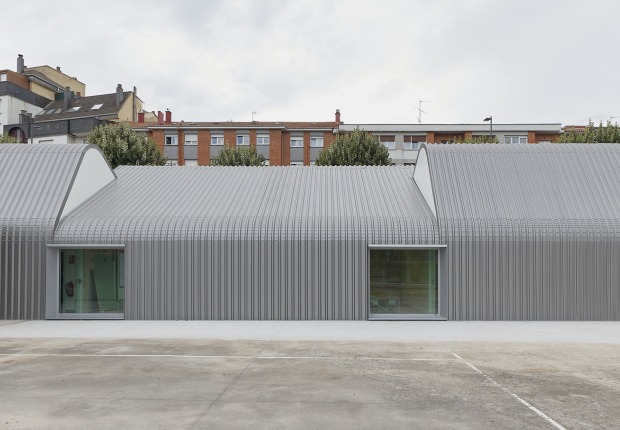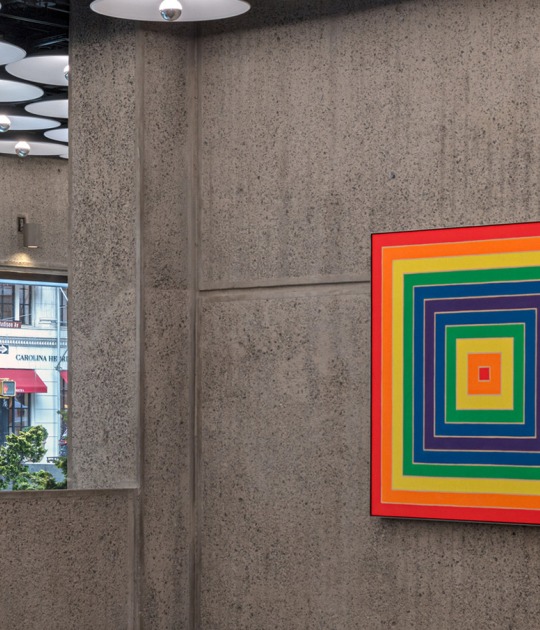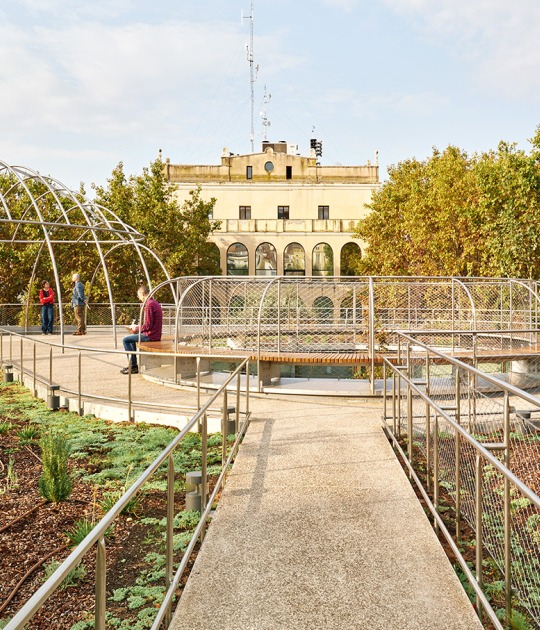With the materials used for the façade, the project aims to build a bridge between the industrial world located along the canal and the stone city. The color of the gray limestone together with the large-format windows make the building appear elegant and open at the same time. The concrete and stone have a similar shade of gray, this creates a large monolith, so that the project, both in size and shape, stands as a kind of rock in the landscape, a reference landmark in the ring of pearls that are intended to be created.
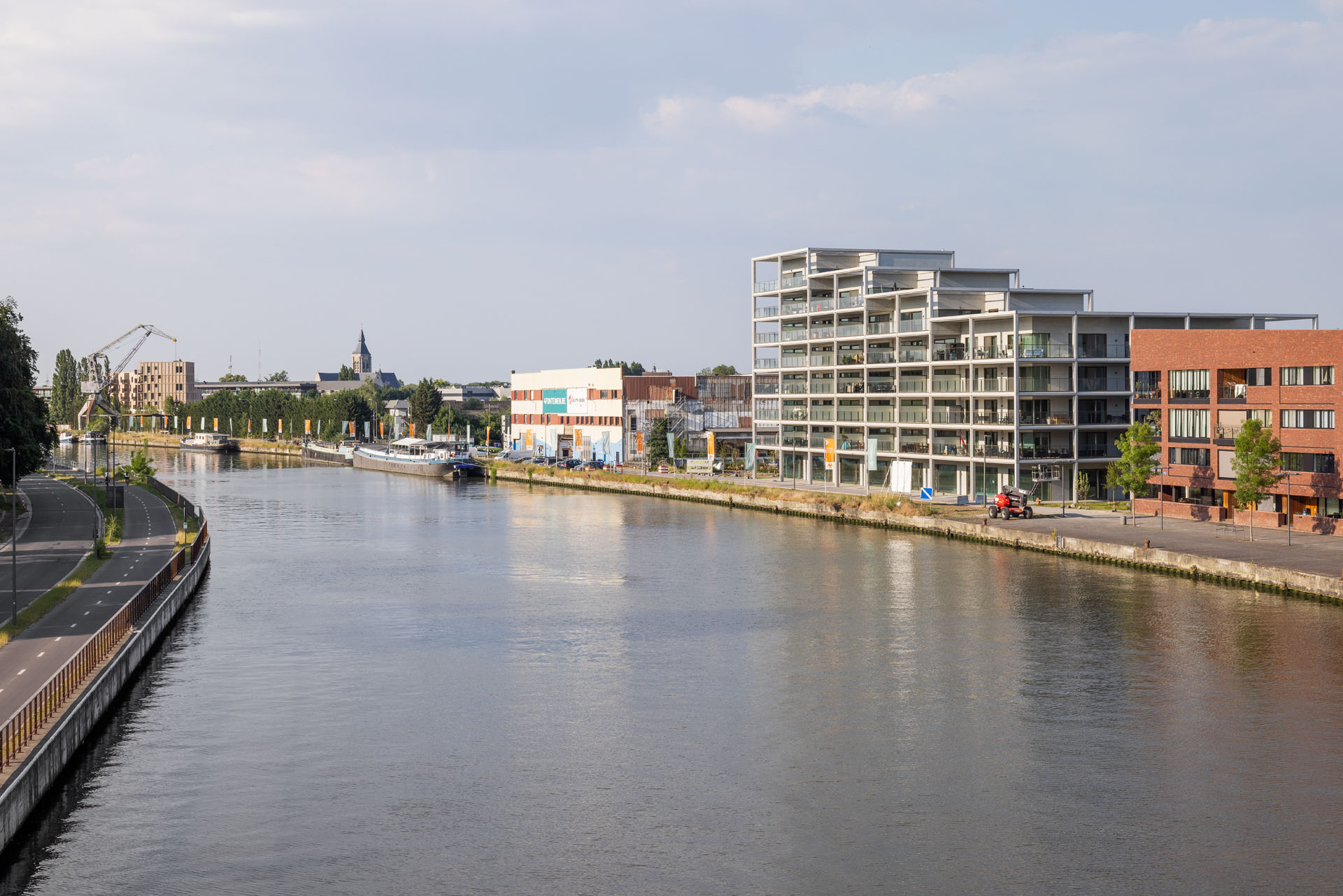
Landmark at the water: Waterzicht by Atelier Kempe Thill architects and planners. Photograph by Ulrich Schwarz.
Description of project by Atelier Kempe Thill architects and planners
A location full of contrasts
Vilvoorde is one of the Flemish cities characterized by industry on the outskirts of the Brussels metropolis. With around 45,000 inhabitants, it is located on the Brussels–Scheldt Maritime Canal. This represents an important transport canal for Belgium and at the same time holds great potential as a landscape element with its spacious layout. An attractive mix of existing industry and urban residential areas has developed along the canal, especially in Brussels. With the redevelopment of the eastern bank of the canal according to the master plan of the urban planning firm BUUR, this development of Brussels continues in Vilvoorde accordingly.
The project “Waterzicht” is part of this new master plan called “De 4 Fonteinen.” It is right on the canal with a view of the 50-hectare De Drie Fonteinen Park on the other side, which dates back to the late eighteenth century and is one of Belgium’s oldest landscaped parks. It was designed as an English landscape garden and creates a romantic atmosphere with its old trees.
The project borders a very fragmented and rugged hinterland on the eastern side. Here some powerful, transformed industrial buildings are situated, on the one hand, and a large working-class area with small terraced houses, on the other. In addition, the small river Senne flows here, which is completely channeled within dam walls. Its banks were replanted as part of the redevelopment above the walls. In the south, the picture is completed by the ring road of Brussels, visible from afar, which crosses the canal at a distance of about 300 meters with the impressive 1,700-meter-long and 35-meter-high Vilvoorde viaduct.

Landmark at the water: Waterzicht by Atelier Kempe Thill architects and planners. Photograph by Ulrich Schwarz.
Architectural urban planning
How should new buildings react to such an urban space? And how can the architecture assert itself at all? What kind of city should be built here?
BUUR’s master plan envisaged a series of powerful architectures intended to enliven the generously designed public bank of the canal like a string of pearls, while at the same time mediating between the large-scale canal side and the smaller-scale hinterland. All the buildings form courtyards on the inside and serve as large structures on the outside. To the south of the project, there was already a generously sized brick building by the architecture firm A2O, which corresponds exactly to this logic.
Various urban planning requirements pertain to the location of the project Waterzicht, giving rise to a great deal of complexity. Along the canal, the building had to be at least five stories high. There is an eight-story elevation accent on the northern corner. On the Senne side, a maximum height of four floors and a volumetric fragmentation were desired to better connect with the workers’ housing.
Programmatically, the ground floor facing the canal should be as lively as possible with shops and restaurants. In the area toward the Senne, living on the ground floor is possible. In addition, the Matexi development company wanted a couple of terraced houses facing the Senne, which typologically are diametrically opposed to the logic of multistory housing.
All of these circumstances created an extremely heterogeneous starting point for the architecture. The challenge then was to ensure a strong bond within this heterogeneity and to unite it as a consistent whole that goes beyond the mere sum of the individual fragments.

Landmark at the water: Waterzicht by Atelier Kempe Thill architects and planners. Photograph by Ulrich Schwarz.
Terraces as a design strategy
Programmatically speaking, the project Waterzicht is relatively simple at first. Shops and restaurants were only planned for the front area of the ground floor; otherwise, there is an underground parking garage and apartments of different sizes developed primarily for sale. There are large, expensive apartments facing the canal with 3.5-meter-deep balconies created especially for the beautiful view of the water and the park on the opposite side. In the roof area, the apartments are designed to descend from north to south, each with terraces running all around on three sides. In addition to a sensible orientation toward the sun, the theme of the stairs responds to the urban-planning desire for a height accent in the north and transfers this concept to the lower parts of the building. Perpendicular to the canal are more affordable, medium-sized apartments. Located on the Senne side, in turn, are four terraced houses with double-height balconies and medium-priced apartments.
All façades, both outside the building and inside the courtyard, are combined with balconies or terraces, which vary greatly in terms of depth and respond differently to the respective living typologies and cardinal points. The spatial openness of the inner courtyard to the outside also creates a direct transition between the courtyard and the outer façade with balconies connecting the inside and outside accordingly. The encircling terraces as an exoskeleton in prefabricated concrete parts hold meaning as a strategically used architectural element that goes beyond the actual living quality. Typological and morphological differences, varying axis dimensions, partly double-height exterior spaces, et cetera, are combined to form a whole without restricting the freedom required for each part.

Landmark at the water: Waterzicht by Atelier Kempe Thill architects and planners. Photograph by Ulrich Schwarz.
Collective yard
The volume of the building encloses a courtyard about 31 meters in length and 19 meters in width, which opens to the Senne on the southeast side. The courtyard is more vertically proportioned according to the volume of the building, especially on the northwest side, which fosters an urban impression. In order to avoid too narrow courtyard proportions and to reduce the vis-à-vis positioning of the apartments, the balconies in the courtyard are rather shallow, in some cases reduced to narrow French balconies.
A special element is created in the courtyard due to the garage entrance with bicycle parking spaces and the elevator, in combination with the entrance halls of the adjacent access cores. This gives rise to another situation where the courtyard opens up to the outside toward public space, allowing the courtyard to be experienced in its depth. The entrance hall, which is directly adjacent to the underground parking garage entryway, has large panoramic glazing, which makes the visual relationships and perspectives even more complex and diverse.
The greenery and the gravel paths in the courtyard engender a friendly, intimate, and homely atmosphere that invites the use of this space.

Landmark at the water: Waterzicht by Atelier Kempe Thill architects and planners. Photograph by Ulrich Schwarz.
Materiality between industry and city
With its façade materials, the project aims to bridge the seemingly contradictory worlds of the industry along the canal with its pollution on the one hand, and the stone city on the other. Gray limestone, high-quality aluminum windows that are thermo-lacquered in a bronze tone, steel-framed glass railings, and precast concrete elements are solid and robust materials, durable in the best sense of the word. With its reserved grayness and large window formats, the building radiates openness and calm elegance. At the same time, the gray also suits the Flemish sky.
Natural stone and concrete are both of a similar gray. This circumstance creates a large monolith, so that the project, in both size and shape, stands like a kind of rock in the landscape. The concrete structure of the prefabricated terraces is designed in accordance with tectonic logic. Supports stand on beams, which in turn rest on supports, thus creating a logic that translates carrying and loads into an understandable visual language for the eye. In order to refine the concrete structure of beams and columns and make the building appear thinner, a rejuvenation of the external view of the elements was introduced. In this way, the concrete elements appear elegant even with slightly smaller spans. The connections between beams and columns lend character to the entire block as an industrial ornament.
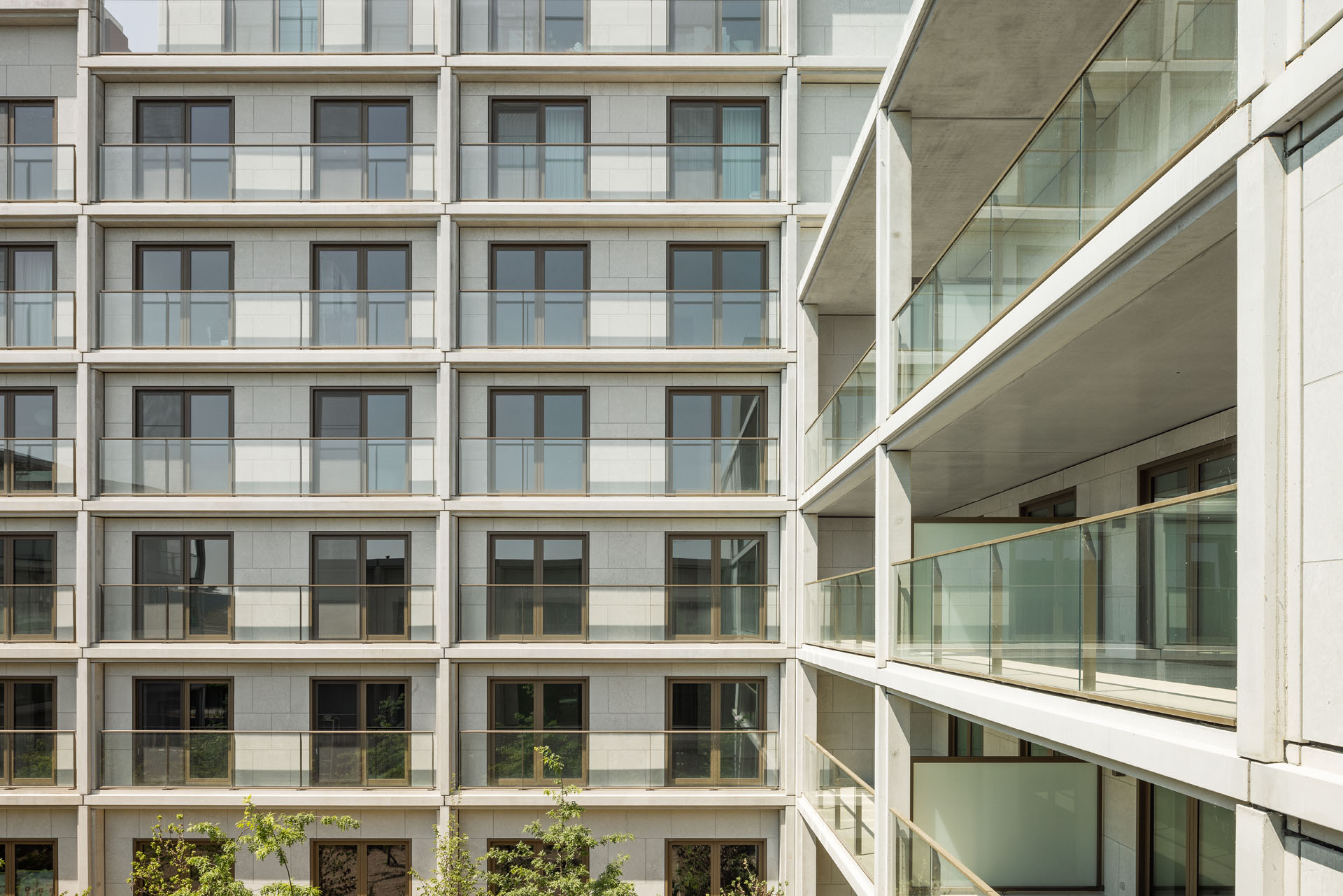
Landmark at the water: Waterzicht by Atelier Kempe Thill architects and planners. Photograph by Ulrich Schwarz.
Responsive landmark
For Atelier Kempe Thill, the project Waterzicht initially represented the logical continuation of the typological experiments of residential buildings with spacious balconies all around, such as those envisaged in the City Palace project in the Nieuw Zuid neighborhood of Antwerp. Here, too, it was a matter of defining a housing typology for the twenty-first century that primarily links high-density urban living with as many suburban spatial qualities as possible. High residential density is combined with openness and lightness as a living atmosphere.
Due to the complex initial urban-planning conditions, however, something new was created: the building is a large sculptural object that has a strong identity and thus establishes its own context and a real identity. It is thus able to fulfill its role as a new strong link in the divergent context and to make a substantial contribution to clarifying the urban-planning situation. It fabricates an island of city and urbanity within a fragmented periphery.

Landmark at the water: Waterzicht by Atelier Kempe Thill architects and planners. Photograph by Ulrich Schwarz.
However, it is not a question of an autonomously set and merely self-referential prototype. Rather, it is a building that, through its architecture, responds sensitively to the different contexts and yet maintains its consistency. On the one hand, architecture refers to the monumentality of the industry along the Brussels Canal through its shape and size, which is also reinforced by the industrial construction methods used. On the other, due to the lower height and the morphological variation caused by the different residential typologies, there is a strong connection to the small scale of the hinterland to the east of the project.
Waterzicht is ultimately an architectural experiment in how much freedom and informality is allowed in building organization, and yet how much unity is needed to experience the project as a whole.


















































